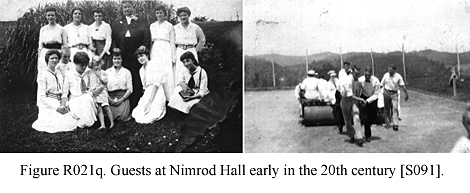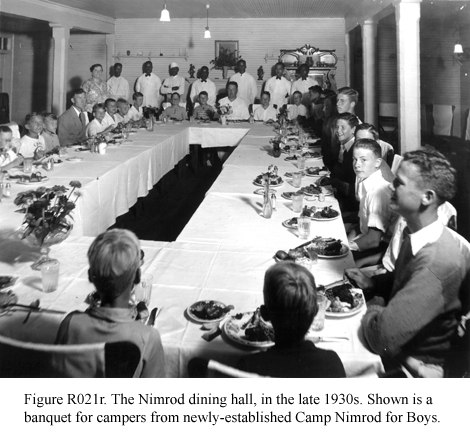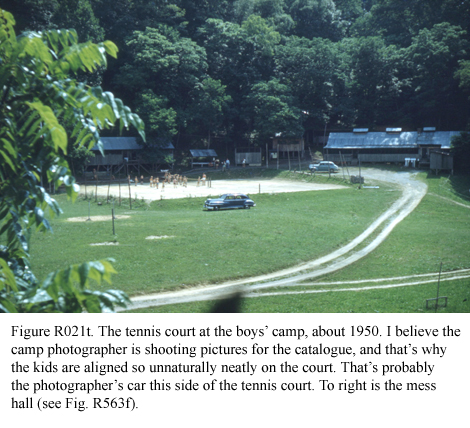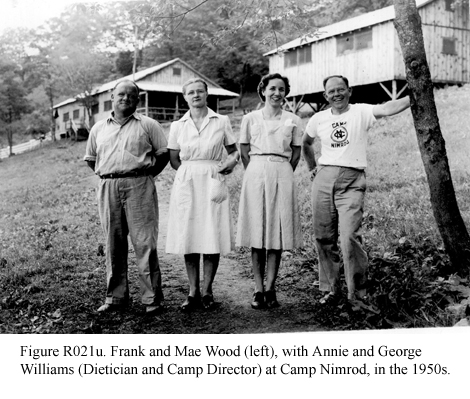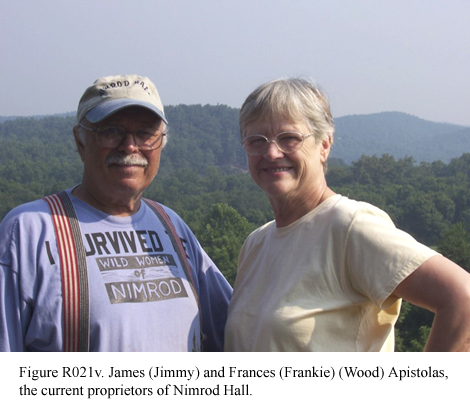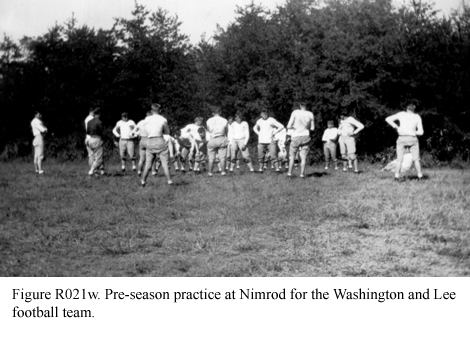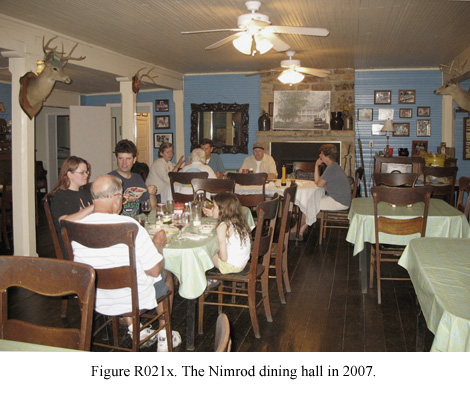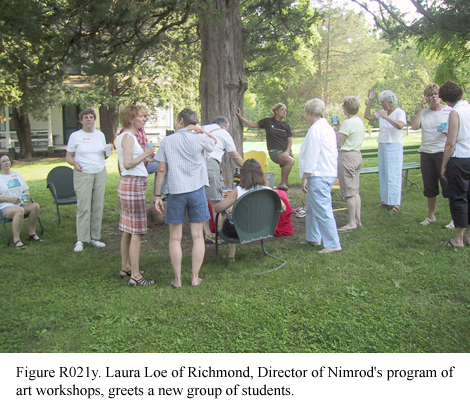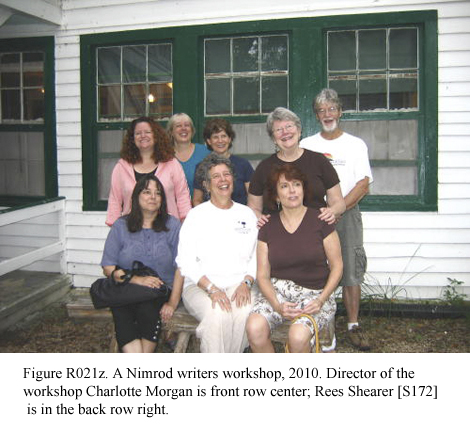R201
Nimrod Hall (concluded)
By 1909 Lewis and Emma Wood had begun operating Nimrod Hall as a summer resort. The Hotel Register they began in that year survives in the Nimrod Hall dining room; the first guest registered 5/22/1909. 104 guests registered that year. Nimrod has continued as a summer resort up to the present day, with the number of registrations varying surprisingly little, between 150 and 200 per season. Emma Wood’s letters [S089] and her daughter Edith’s photographs [S091] provide a rich record of Nimrod as a summer resort in the early 20th century. The guests depicted in photos are well-bred, well-dressed young people, often engaged in celebrations or hijinks but also capable of rolling the tennis courts (Fig. R021q). Some of the Wood children are shown joining these well-to-do guests in their activities, which must have affected their rural outlooks to some degree.
The adaptability of well-born city people to Nimrod country ways was remarkable, but not perfect. The writer taped an interview in 8/1993 with McDonald (Mac) Wellford: “The ladies, for the most part, didn’t relax and enjoy themselves as much as they do today, and I well remember going down [from Richmond] to the Nimrod Hall and having breakfast, and my aunt—it was Mrs. Mary Allen—had her chauffeur drive her up here in her new Buick, and she stayed in the square cottage on the second floor, and that morning at breakfast my grandmother was dressed in relaxed clothing that would be suitable for being in the country, but aunt Mary came down with a hat on—a Queen Mary hat, we called them, because they sat on the top of the head—quite a display, and she was dressed up for city life. And my grandmother said, ‘Mary, why are you dressed like that? Why don’t you put on some older clothes?’ Aunt Mary said, ‘Jeannie, I’m going back to Richmond today.’ And my grandmother said, ‘Mary, why in the world are you going back?’ She said, ‘Because I came up here to relax, and I didn’t get a bit of sleep last night. The first thing I knew, I’d gotten to bed, and I heard these crickets. And there were other bugs, locusts and what-not that were making a great deal of fuss, and I just couldn’t go to sleep. At the crack of dawn I heard the cows going “Moo-o-o-o.” I couldn’t go to sleep then, and so I’ve decided to go back to Richmond, and I’ve told my chauffeur to be ready to go in an hour.’”
Nimrod Hall at that time was almost completely self-sufficient. It had a full-scale working farm that produced meat, poultry, eggs, milk, vegetables, and fruit. And it had to be self-sufficient in lighting its rooms, because electric power lines were not put through the area until about 1940. However, until 1920 the light consisted of oil lamps. In that year, no doubt responding to the rising expectations of his guests, Lewis Wood installed a “light plant.” In 1922 he added two private bathrooms to the sunset cottages, enabling him to upgrade the Nimrod letterhead to read

The light plant consisted of a gasoline-powered Delco electric generator in a shed in the back yard, which was run once a week to charge a bank of storage batteries. Reportedly the system delivered 32 volts DC. Nimrod relied on this power supply until the early 1930s. Where Nimrod most seriously lacked self-sufficiency was in the matter of ice. Large amounts of it were needed to refrigerate the food used by an institutional kitchen. Whenever the winter was cold enough the Nimrod people would break slabs of ice from the Cowpasture River, drag them up to the Hall with a tractor, and store the ice packed in sawdust in an icehouse that was sunk into the ground behind the main house. But about half of the time the winter was not cold enough to collect ice, and this meant frequent trips on the bad county roads to Millboro during the summer to buy 300-lb blocks of ice and haul them home. Until about 1935, a good winter for Nimrod was a very cold winter.
Nimrod was always blessed with abundant clean water from the spring at the head of the pond, but getting it from there up to the Hall was not a small problem. As Gordon Blair [R917] points out, in the 19th century a two-wheel frame with a barrel on top of it had to be filled by hand at the spring then drawn by a yoke of oxen up the hill. I have not heard when a pipeline, a mechanical pump, and a reservoir at the top of the hill became available, but no doubt well into the 20th century.
These technical problems were largely solved after the 1920s. About 1935 Frank Wood and his friend Bill Hartmann installed a DC power generator on the pond dam below Nimrod where earlier there had been a grist mill. This delivered 15 kilowatts of (nominally 117 volt) power, none too much when the system it supplied was stretched as far as it got stretched. To quote Gerald Wood [R602] (1993), “...when the DC generator was on, and Nimrod was operating, Frank had his camp on there, he had Nimrod on there, Grandmaw’s house, and this store here [Russell Wood’s Esso gas station, across Rte. 42 from the entrance to Nimrod], that was the last thing on there. And a many a night, those little bulbs Dad had in the front of it? You had to look real hard to see if they were on. There just wasn’t anything left!” Continuing,
“...I can remember many times, whenever an electric storm would come up in the summer, there was a little stick down under the big flywheel, and a little dynamotor down under there that was geared to the flood gate. When a thunderstorm would come up, everybody knew it was everybody’s responsibility to turn that thing off. And you took this little stick, and stuck it in this cogwheel? And you started winding it. And as it turned the gate, well that let the water away from the turbine and over the spillway. And as you cycled it down, you had a great, big, knife switch— ...you couldn’t pull it off, until you took the power off it. If you did, a ball of fire would fly off of it like that, and I was scared to death of it anyway. But a few times, we didn’t get there in time. Lightning would get on the thing, backfeed, and take the generator out. Then it was a melee to back a truck up and get all the ramps and that thing weighed about 800 pounds. We’d skid it down and onto the truck...had to take it to Roanoke and rewind it. And it was one of those things that had to be done! Because Nimrod was running refrigerators. And the old... do you remember the old... what gas did they use in ‘em?... Ammonia gas! Anyway, if one of ‘em sprung a leak, you had to vacate the premises. And this happened continuously, until they got modern walk-ins.”
Another important issue at that time was the muddy/dusty highway, Rte. 42, which provided access to Nimrod Hall. Its primitive rutted condition became more and more of a handicap as Nimrod’s dependency upon Millboro ice grew and as potential guests thought it more and more unreasonable that they could not comfortably drive their “machines” to and from Nimrod. The Commonwealth planned to straighten and pave the road, and sent engineers who stayed at Nimrod while they planned the project. The trouble was, the road work was to be done by convict laborers—chain gangs—and the local residents were not enthusiastic about the idea of quartering convicts in the neighborhood for several years. The exception was Lewis Wood, who was enthusiastic, for economic reasons. He offered to let the Commonwealth build a camp for convict laborers on his property, between Nimrod and the highway, which it did, about 1933-35. There were no ill effects of this experience except that Lewis had to endure the wrath of daughter-in-law Madge Wood, whose home lot abutted on the convict encampment.
In 1936, an important change in Nimrod’s cash flow picture occurred when Lewis’s son Frank Wood opened Camp Nimrod for Boys on the property, in the area shown in Fig. R021c. The camp (Figs. R021t, R021u) endured and influenced the maturation of boys for 48 years. In 1939 Franks’s sister Mattie Wood opened Camp Nimrod for Girls at a position discretely removed from the Boys’ Camp (Fig. R021c).
In the late 1940s Nimrod switched over to commercial AC power service, but not abruptly. For several years Nimrod Hall had two isolated power circuits, one for AC and one for home-generated DC power. Then the DC generator at the dam was turned off; the powerhouse was finally destroyed by flooding of the Cowpasture River caused by Hurrican Hugo in 1984.
Unfortunately, along with these improvements in the technical situation over time went declines in the agricultural and humanistic pictures. One by one the farm products that fed Nimrod Hall and the boys’ camp stopped being economical to produce at Nimrod and were replaced by commercial foods (because of increasingly scarce farm labor, the small scale of the Nimrod operation, and tightening public health standards) until now nothing is left but a small kitchen garden; the outbuildings behind Nimrod that had been a chicken coop, a hog-slaughtering facility, etc. were abandoned and eventually demolished. The boys’ and girls’ camps were shut down in 1984 for a variety of practical reasons.
In 1965 the old kitchen of Nimrod, with its massive iron coal-fired stoves and original root cellar, was rebuilt and re-equipped along modern lines.
The management of Nimrod passed from Lewis Wood, as he grew old, to his son Frank (Fig. R021u) about 1930; from Frank, when he died in 1980, to his wife Mae; and then on her passing in 1988, to their daughter and son-in-law Frances Marion (Wood) and James Apistolas (Fig. R021v), who inherited the property. Jim and Frankie still maintain Nimrod as a summer resort. They have labored heroically, with little help from hired labor, to maintain the huge loveable old white elephant. It remains in excellent condition, but some of the high-maintenance Victorian frills from earlier times have not survived—the shutters, balustrades, and picket fences.
Nimrod Hall has been a home, a farm, and a summer resort; but it has also played other roles. For example, between 1933 and 1938 Nimrod was used as a pre-season training camp for the Washington & Lee football team (Fig. R021w). A football field with wooden goal posts was laid out in the river bottom field that had earlier held a track for horse racing. Between 1886 and 1970 Nimrod Hall was a U. S. Post Office, with its own cancellation stamp.
And, in 1961, NASA Astronauts were guests at Nimrod! See [S184].
The Nimrod Hall summer resort closes after Labor Day, but it reopens as a hunt club in the fall during deer hunting season, remaining true to the tradition of the Smiths and Watsons in the 19th century. This operation is supervised by Frankie’s sister Sarah Davis. Now the dining room walls, so pristine in Fig. R021r, are decorated with antlered heads (Fig. R021x; compare with Fig. R021r, above).
Most recently, Nimrod has supported the arts. Beginning in 1986, it has hosted a series of weekly art workshops in the summer (Fig. R021y). Since 1991, writers’ workshops have also been held at Nimrod [R021z]. As of 2009, attendees at these workshops have occupied almost half of Nimrod’s guest accommodations.
Colorful accounts of life at Nimrod in the 1920s and 1930s can be found in the pages for grandchildren Charles Wood [R600], Gerald (Son) Wood [R602], and Dorothy Wulfers [R603].
Epilogue
In 2013 Frankie and Jimmy Apistolas retired, and sold Nimrod Hall to Will Loving and Laura Loe (Fig. R021y) of Richmond Virginia. Thus Nimrod has passed from the ownership of the Wood family after 104 years, but it will continue as an art colony and a summer resort under the loving (no pun intended) care of its new owners, who have a lengthy Nimrod background and an appreciation of its rich history.
